Introduction
I received my first tape recorder in the summer of 1964. It was an RCA 7″ reel, half track mono, which ran at 17/8, 3-3/4, and 7-1/2 IPS. I recorded radio station broadcasts, and copy borrowed 45s to record in a “pre-mixtape” era.
Some of my tapes were then copied for friends. I sure wish I had that machine, and also the tapes. I had recorded nearly 50 tapes on .5 mil at 17/8 of stations like WKNR Detroit, WTOD and WOHO Toledo, and even WCFL and WLS from Chicago. Wouldn’t that have been fun to listen to, again?
I also traded tapes with people I knew. A kid down the street had a father who loved jazz, recorded jazz LPs, and recorded local groups who played at a bar in south Toledo. He recorded artists at the old “Rusty’s” in the south end of Toledo, Ohio? It was fun, and opened up a hobby and career for me.
By 1967 I was a tape-a-holic, trading and recording a lot of content off borrowed LPs, 45s, the radio, and even live performances. I was learning about tape recording, and luckily, I had my brother who worked in radio, and his friends in radio engineering showed me the proper way to maintain and care for tape machines.
By my junior year I was repairing and cleaning those old Wollensak T-1500 reel-to-reel tape recorders in the Whitmer High School A/V department. Before I could legally drive a car I was following around guys 20 and 30 years my senior, helping them servicing tape and cart machines. I didn’t get paid for it, but the experience was priceless!
Enter Dolby B
In 1968 Dolby-B noise reduction came out for the consumer market, mainly marketed to the cassette crowd. The “Dolby” name comes from Ray Dolby the scientist behind the noise reduction method. I met Ray at one of the engineering shows and he was patient explaining the process of the technology to a young kid. I was greatly appreciative for the lesson.
The Dolby-B noise reduction system typically made reel to reel tapes about 10 dB quieter, which was a blessing in the days of Scotch 111, 170, and their Ampex 631/641, Radio Shack, Shamrock, and Audiotape equivalents. This was before the age of better formulations of low noise tape came out. And ironically, a lot of those tapes still play perfectly, while newer tapes suffer the dreaded Sticky-shed syndrome.
A friend, and local radio engineer, Dave Collier, introduced me to Dolby B.. He used it on a Revox A-77, quarter track tape deck for recording classical and church choirs in 2-track, at 7-1/2 IPS. The quality was very good. As I recall, his unit were made by Advent. A good technical description of the Dolby-B process can be found on Sweetwater Sound’s web site.
Radio Shack had just come out with consumer tape recorders and cassette machines with Dolby-B integrated into the machines. This was a game changer for cassette users.
Radio Shack also sold an outboard consumer Dolby-B unit, the Radio Shack model DNR-1 Noise Reduction System, model number 14-893, (seen below). It was designed to be an “add-on” to a home stereo system. Under the top grey cover were the pots for alignment with the tape machine audio levels. It came with a 5″ reel, and cassette, containing alignment tones.
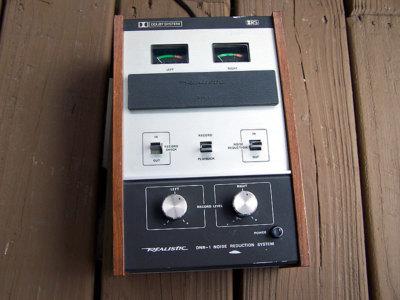
The DNR-1 was very functional and useful in situations where tape noise was a problem. Live school and church performances, spoken word, and even private music sessions benefited from 10 dB less tape hiss. I recall one recording made of acoustic, 12 string guitar which was album grade by early 1970s standards.
When copying from reel to cassette, (using Dolby B) the quality was noticeable over straight no noise reduction copies. Many of the early 70s tapes I recorded were encoded in the Dolby-B format and still sound good today! As a side note, Dolby B was not intended to remove all noise, as some “audio phules” think, but just take 18 to 12 dB of tape hiss out of the quiet passages.
When dubbing from a Dolby B tape you could sometimes cheat the system by copying to a fresh tape, as long as the 400 hz calibration tone was present on the new tape at 0VU. Yeah, it’s not perfect, but it did work for general purpose, non-studio copies. A few people I knew in the United Kingdom and I traded tapes this way.
Playing back Dolby-B tapes without a decoder sounds odd, since Dolby works by boosting high frequencies on record at low levels, and reducing high frequencies, (and recorded noise), upon decoding/playback. So if you listened to the playback of an un-decoded tape, at near “zero VU” levels may sound a little more treble, but as level dropped it was more noticeable.
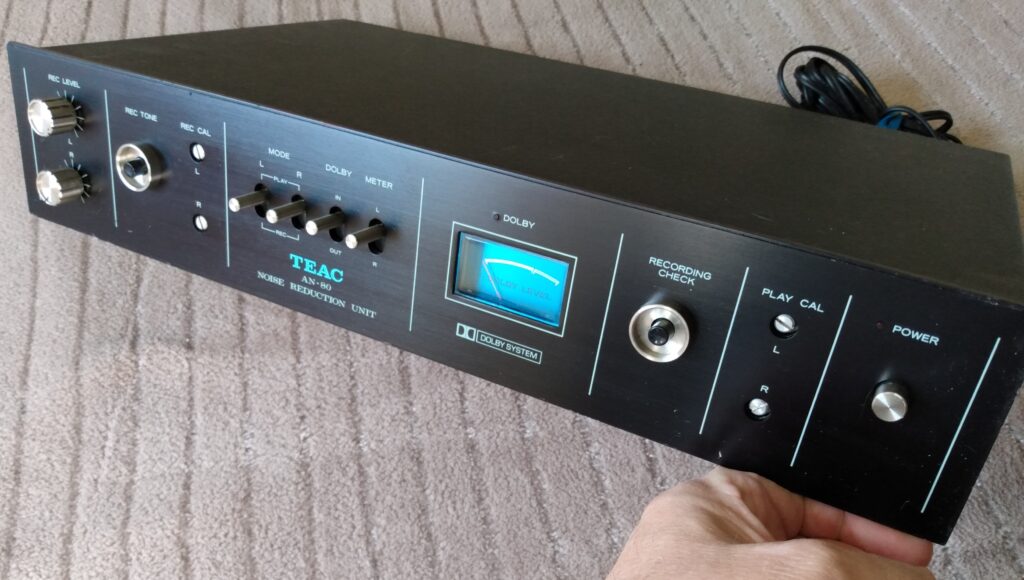
Dolby-B received a very bad rap because non-professional users who recorded with different brands and formulations of tape found the playback sounded funny.
Recording of tapes on machines not properly biased and aligned to the tape caused tracking errors. Not all tape is alike, and different tape produced different EQ and level reference
Regardless, it worked for me because I knew how to use Dolby properly, and I still have more than 2,000 tapes recorded in either the quarter, or half-track format with Dolby-B. Some of these tapes contain recording sessions and content which are priceless.
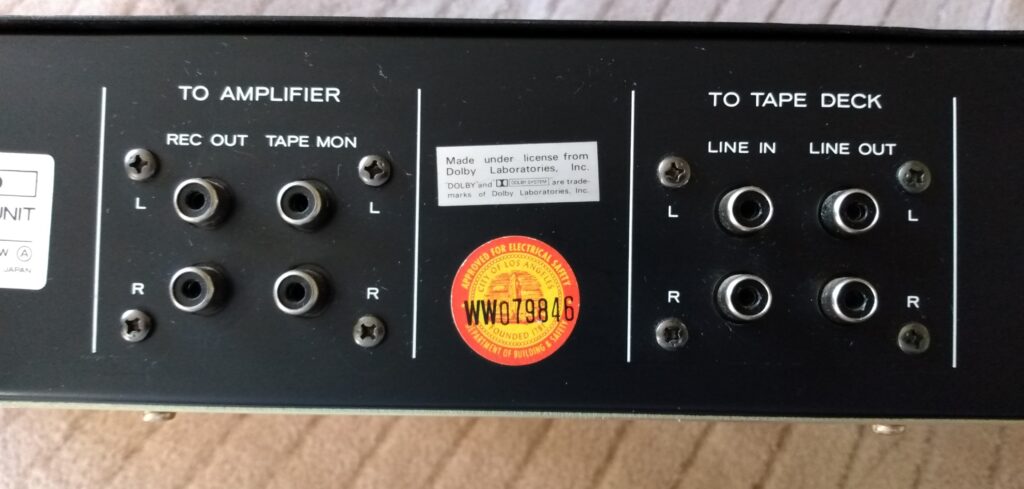
In 2020, (and getting close to retirement), I decided to copy off many of my tapes. Dolby units were retrieved from storage, re-capped, aligned, and cleaned up. But now I had another problem.
Over the years I had converted my entire audio room to rack mounts. I use standard rack like you see in radio, TV, and recording facilities. So, what now? The answer was clear, build rack mounts for classic non-rack gear!
Creating Rack Mounts
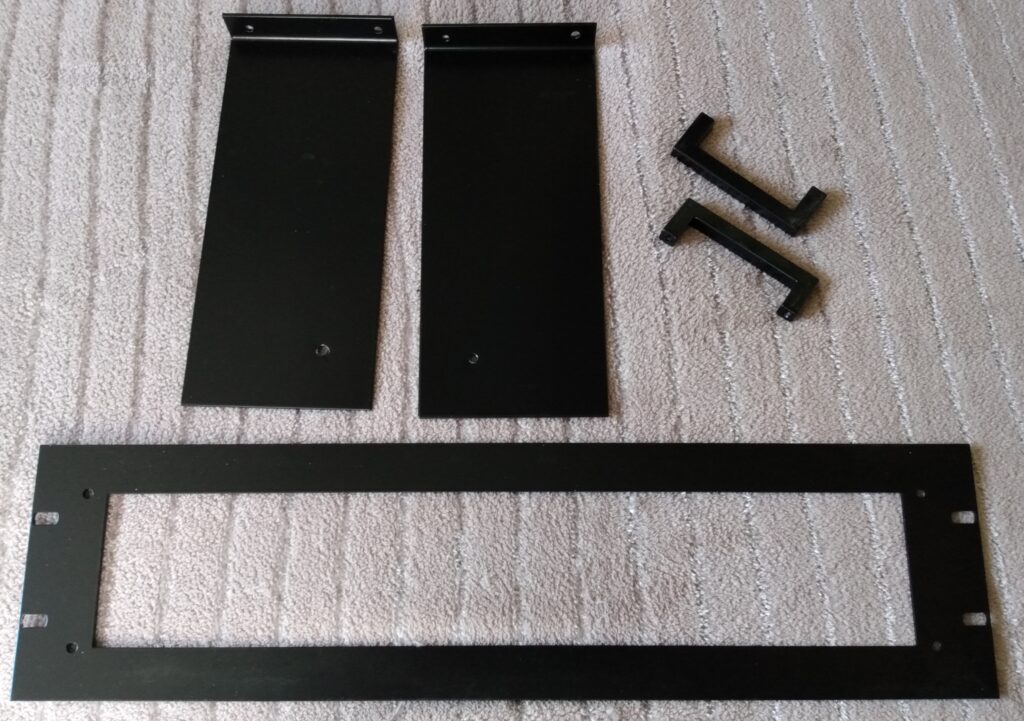
I designed my rack mounts around three pieces. A front plate/panel, side supports, and handles.
You can design a shelf system and have the equipment sit on a tray, and even make a face panel to cover the front. There are also companies that will make them for you. With a tray, unless you secure the unit, when you press a button on the front of the equipment, the gear can get pushed back into the tray. This can be fixed by installing a stopper in back of the machine.
The side supports mount to the unit using an existing screw used to hold on the cover. It then attaches to the front panel. A #8 screw attaches the side support, through the front plate, and is captured by the handles. When everything is tightened up, nothing moves. Its all one piece ready to go into the rack cabinet.
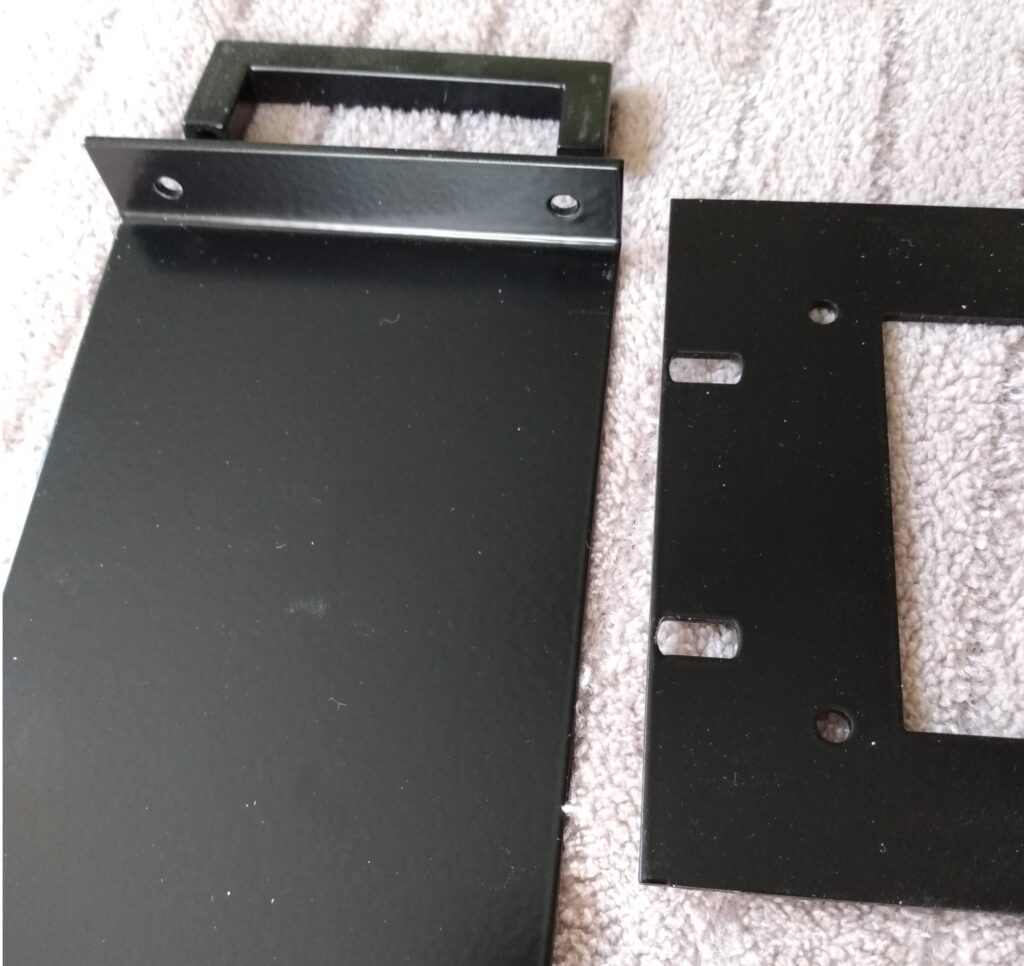
The side panel is made of steel, with a .5000″ lip bent at 90 degrees. The holes on the bend correspond to the handle alignment, and line up with the front panel. (See the pictures to the right.)
When assembled, the front plastic panel of the AN-80 is tight against the front rack panel. The front is held together with the screw mounting of the handles.
The back is captured to the equipment by a screw which goes through the side piece into an existing hole on the AN-80 used to secure the cover. (Note, this screw is a metric.)
If the existing screw from the AN-80 is not long enough, you will need to get another screw which needs to be about .375″ long.
The side panels are easy. Just a 90-degree bend, locate where the holes need to be, and you’re done. The front panel can be a little trickier. There are three ways to make one.
1 – You can make a rough rack panel with opening with a band saw, or scroll saw, with a lot of care and patience. Aluminum plate is available at most home store like Lowes and Menards.
2 – Optionally, have Front Panel Express make them for you with their easy to use software. You design the panel, send the file to them, and they make it and sent it back to you.

3 – Another source is Markertek’s custom metal services, which I’ve used in professional builds. Markertek also has blank panels, sold separately, and in bulk “contractor packs“.
4 – If you have access to a CNC machine you can make panels easily. The stock should be at least 0.0787402″ thick (2mm), 19.00″ wide by 5.25″ tall, for a three RU panel. The Teac AN-80 required a rectangular hole, (4) round holes for mounting the side plates to the front panel, and (4) oblong holes for mounting to the rack mount to the rack cabinet.
The handles were from Lowes, kitchen cabinet department. Specifically, I used “Rusticware” 3.0″ Center to Center Chrome Rectangular Handle Cabinet Door Pull, Item #1442765, Model #993CH, ($7.53 each, need 2).
I use the square style handle for my audio gear, and the round chrome handles for my RF and ham radio equipment. (The Sugatsune Cylindrical Handle Cabinet Door Pull, Lowes Item #1270138, Model #H-42-B-8, is perfect for 3.5″ rack panels). With grey paint, and chrome handles, it has that “military look”.
After all the metal panel parts are made, I took them, and the handles, to a powder coating shop and had all the parts coated the same color as the Teac AN-80. They used PPC “Satin Black” powder coat, and the match was perfect to “Teac black”.
While metal and paint were underway, I recapped the AN-80 so I had ready for action when the panels were attached. I also changed the VU meter incandescent lamp to a soft blue LED.
As soon as all the AN-80 Dolby units are done I have Teac AN-50 and AN-60 to do. Also on the build schedule are rack mounts for a Teac X7R and Tascam A3440 reel to reel machines. I don’t think I’ve seen Tascam A-3440 rack mounts in 20 years!
Here is AN-80 #1 hot off the bench in it’s new rack panel.
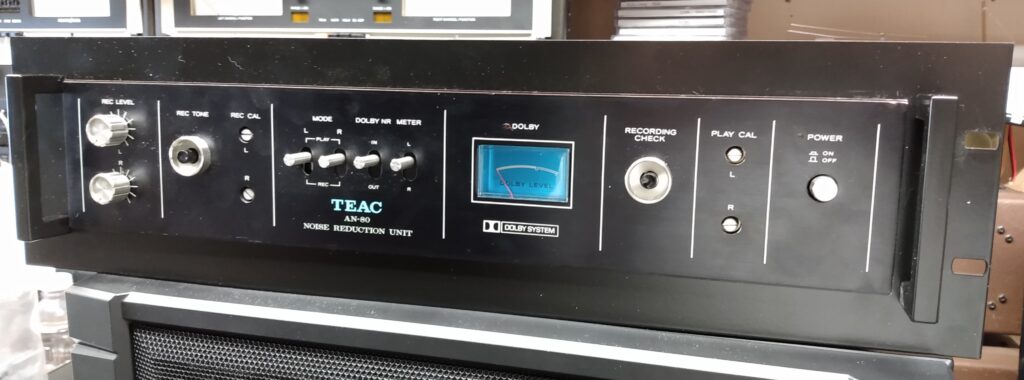
References and Resources
1). Format Characteristics and Preservation Problems Version 1.0 – [PDF]
2). Richard L Hess—Audio Tape Restoration Tips & Notes – [Web Page]
3). Fun article from the Chicago Tribune – [Web Page]

It’s been a long, long time
The time arrived. I’m now RETIRED, as of September 29th, 2023, from long hours, early rising, and nightly phone calls.
I always said that when you start to grow disenfranchised, and dreaded coming to work …. it’s time to exit.
I worked at the TV station since June 20, 1985. Before that there were multiple radio jobs, two stints in major recording studios, a couple summer jobs in cable television, an audio console manufacturer, and even test equipment for marine engines. The journey started May 15th, 1968, while still a kid.
By the numbers, my employment was 20,225 days, 5 hours, and 30 minutes. Or 29,124,330 minutes. And during 1968 to 2023 I was only unemployed 132 days, 86% of which was Covid-19, and the balance radio drama. You know the drill. “We’re changing format, so you’re out!” Pack the U-Haul and move on. Radio Gypsy.
I started in radio quite by accident. I didn’t have my drivers license yet, but I wrangled a job at a radio station as janitor to make a few bucks, (back then $1.50 per hour). The station was what they called a “progressive rock” station. When the D.J. overdosed, they needed someone to get on the air quick, and against my protests I was thrown in the studio.
The chance started in Berkey, OH, at a mono FM on 105.5, licensed to Delta, OH. When I was there it was a mish-mosh of progressive rock from a Gates “Yard” board, Gates turntables, and ATC cart machines, and a Gates FM-3H transmitter, and records from a “head shop” on Sylvania Avenue in Toledo. I had an epiphany. I could do this! I stayed, learning as I go, and between long songs did my homework for school.
Unknown to me at the time was that you could not operate a broadcast transmitter without a license. But, the station manager didn’t care. Rules never concerned him. The station had gratuitous sex, free flow of drugs, and ads for every adult bookstore or movie house, and carry-outs in only the sketchiest places in town. It was the best opportunity for a young kid to get familiar with the business without being licensed. The station finally when bankrupt, and was sold to the owner of a successful AM station in Toledo, and became automated easy listening.
During that time, a fellow who I knew, who was Chief Engineer of WQTE 560 Monroe, Michigan, suggested getting my F.C.C. license. I was interested, but scared at the 400′ towers, and all the RF. Maybe I should start smaller. But he pressured me because he knew I needed the license to get a job. I studied for about 3 months until I felt confident.
My mother drove me to the F.C.C. Field Office on Jefferson Avenue, in Detroit, and I took the test. It was a hard test, and intimidating. The exam room was small, decorated in typical 1940s government desks, and everyone who was there was older than I. It was terrorizing hearing older guys sigh in frustration, or muttering “I don’t know this”, or the examiner whispering, “Sorry, you can try again later”. I think that April 15, 1968 day saw more people fail the test, and a couple gave up and walked out of the exam.
After handing in the exam, I sat and waited for my rejection. The test was a lot of electronic theory and math. Eight minutes later, (I remember watching the clock), the examiner, Richard Cotton, (FCC Detroit Field Chief Engineer), pointed at me with a scowl, and gave me the hand signal, ‘come here, kid’. I walked up, prepared to meet my fate, but he smiled and whispered, “Great job, kid!” Holy cow! I passed! I never did find out if a squeaked by or passed with a decent score.
After leaving the progressive rock station I found another opportunity, (for $1.55 per hour), at WMHE-FM, mono 92.5 in Toledo, to play what amounted to background music off LP records. The station was closer to home, 2.43 mi (3.91 km) which was much closer than the rock station, so the nickle differential plus travel time/costs made it better. If it was a good day, I would walk.
The format was bone drying boring. Play music for 15 minutes, play a 3” reel of an ad, or maybe 2 off an old Magnacord reel machine, ID the station, and …. repeat. The hours sucked, Friday and Saturday from 6PM to 6AM. Yep, 12 hour shift. The studio was in an eight foot by eight foot room, in the design of a military radio room, all battleship grey. The audio board was mono and built by the Chief Engineer. But, it was radio!
The station’s big money maker was background music, Muzak™, and they had the lock on a six to seven-county area with subscriber rates at $30.00 per month, (1968 dollars). Every business had their service. It was a money maker, (except for staff).
From there I got into pop radio, did the “gypsy tour”, going from station to station, market to market. The radio career was up and down, and I saw the greatness as well as the belly of the beast. Good people, bad people. Even a couple brushes with death.
Marriage took part between a move from small market, to medium market, to the Detroit radio market. Starting out it was not that bad of a move since we remained in a 40 mile radius of our hometown.
TV started, quite honestly, by accident. I was holding down two jobs while living in Detroit. At one of the jobs, (the minority owned TV station), I was prompted by the Chief Engineer of WGPR-TV to investigate the Chief Engineer’s job in Lima. I went to the interview, and my qualifications apparently impressed them. I was hired on the spot with a pay grade higher than Detroit! My first day was baptism by fire, since the station did a long telethon for St. Jude’s Children’s Hospital.
From there I became the company’s Group Director of Engineer, a deputy for the EMA, pastor, amateur radio operator, publisher of a magazine for the blind, and several other personal achievements.
So where do we go from here? Well, camping, scratch building microphones, maybe an internet radio station (feed from my Part 15), DJing on WNAP from 10A-3P weekdays (Brother Buzzard), voice over work, and a few other things.
After a health scare in 2021, (Covid), I started thinking about retirement. The post-Covid business doldrums in business pushed the issue. Young employees not working, apathy by coworkers, and a general lack of quality made me think even more about calling it quits. And sadly, I see this all over; from restaurants, to service providers, to contractors, everyone is having problems with people showing up to work, or giving 100% if they are working.
My final hurrahs were the F.C.C.’s RePack where I had to coordinate the move of our high power stations to a new $10-million transmitter site, rebuilding three low power stations, and a brand new automation system. The transmitter site is perhaps the jewel as I had to balance the costs between making a nice looking site, which was sustainable, low maintenance, and multi-functional.
So it’s time. Not necessarily time to relax but remain active in things that my family and I want to do. I have plenty of home, amateur radio, scanners, audio recording, writing, and machinist projects. After all these years I don’t see a change from getting up at dawn and doing my thing, but this time under MY timeline, and MY family’s needs. And when we feel like taking off and going on an adventure, or visiting family, we’ll do so without checking to see if it’s OK.
PS: I hope to get this blog shaped up. It’s been too long neglected due to other priorities.
Contact Information